美的系冷柜基础知识
- 格式:pptx
- 大小:4.15 MB
- 文档页数:38

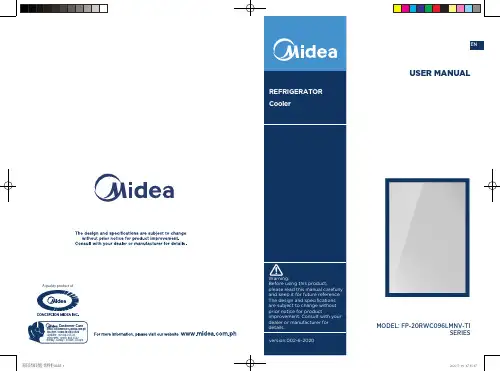
111-212Meaning of safety warning symbols 313Electricity related warnings 314Related warnings for use415Warnings related to placing items 516517Warnings related to disposal521Names of components 622723Placement 824Start to use88827831 9329339WarnningWarnings for energy Temperature Control 2.5 The arrangement of bottle26Usage of temperature zones inside the Wine Cooler Disconnect the cooler Stop using the cooler Clean the cooler Energy saving tips1Safety warnings2Proper use of Wine Cooler3Maintenance of Wine Cooler4T ····· ·10DEAR CUSTOMER:Thank you for buying this Wine Cooler. To ensure that you get the best results from your new Wine Cooler,please take time to read through the simple instructions in this booklet.Please ensure that the11 Safety warnings1.1THISappliance is intended to be used in household and similar applications such as staff kitchen areas in shops, offices and other working environments; farm houses and by clients in hotels, motels and other residential type environments; bed and breakfast type environments; catering and similar non-retail applications.THIS IFthe supply cord is damaged, it must be replaced by the manufacturer, its service agent or similarly qualified persons in order to avoid a hazard.DOnot store explosive substances such as aerosol cans with a flammable propellant in thisappliance.THEappliance has to be unplugged after use and before carrying out user maintenance on theappliance.WARNING : Keep ventilation openings, in the appliance enclosure or in the built-in structure,clear of obstruction.WARNING : Do not use mechanical devices or other means to accelerate the defrostingprocess, other than those recommended by the manufacturer.WARNING : Do not damage the refrigerant circuit.WARNING : Do not use electrical appliances inside the food storage compartments of theappliance, unless they are of the type recommended by the manufacturer.WARNING: Please abandon the refrigerator according to local regulators for it use flammableblowing gas and refrigerant.WARNING : When positioning the appliance, ensure the supply cord is not trapped ordamaged.WARNING : Do not locate multiple portable socket-outlets or portable power supplies at therear of the appliance.DO not use extension cords or ungrounded (two prong )adapters .DANGER : Risk of child entrapment .Before you throw away your old refrigerator or freezer:-Take off the doors . -Leave the shelves in place so that children may not easily climb inside .THErefrigerator must be disconnected from the source of electrical supply before attempting theinstallation of accessory .appliance is not intended for use by persons (including children) with reduced physical,sensory or mental capabilities, or lack of experience and knowledge, unless they have been given supervision or instruction concerning use of the appliance by a person responsible for their safety.)risk of fire / flammable materialsWarning :REFRIGERANT and cyclopentane foaming material used for the appliance are flammable. Therefore, when the appliance is scrapped, it shall be kept away from any fire source and be recovered by a special recovering company with corresponding qualification other than be disposed by combustion, so as to prevent damage to the environment or any other harm.CHILDREN should be supervised to ensure that they do not play with the appliance. FOR EN standard: This appliance can be used by children aged from 8 years and above and persons with reduce physical sensory or mental capabilities or lack of experience and knowledge if they have been given supervision or instruction concerning use of the appliance in a safe way and understand the hazards involved. Children shall not play with the appliance. Cleaning and user maintenance shall not be made by children without supervision.Children aged from 3 to 8 years are allowed to load and unload refrigerating appliances.TO avoid contamination of food,please respect the following instructions:– Opening the door for long periods can cause a significant increase of the temperature in the compartments of the appliance.–Clean regularly surfaces that can come in contact with food and accessible drainage systems.– Clean water tanks if they have not been used for 48 h; flush the water system connected to a water supply if water has not been drawn for 5 days. (note 1)– Store raw meat and fish in suitable containers in the refrigerator, so that it is not in contact with or drip onto other food.– Two-star frozen-food compartments are suitable for storing pre-frozen food, storing or making ice-cream and making ice cubes. (note 2)– One -, two -and three-star compartments are not suitable for the freezing of fresh food. (note 3)– If the refrigerating appliance is left empty for long periods, switch off, defrost, clean, dry, and leave the door open to prevent mould developing within the appliance.Note 1,2,3:Please confirm whether it is applicable according to your product compartment type. WARNING:To avoid a hazard due to instability of the appliance, it must be fixed in accordance with the instructions.WARNING:Connect to potable water supply only. (Suitable for ice making machine)TO Prevent A Child From Being Entrapped, Keep Out Of Reach Of Children And Not In The Vicinity Of Freezer (Or Refrigerator).″(Suitable for products with locks )231.2 Meaning of safety warning symbols1.3 Electricity related warningsTo ensure safety, it is not recommended that to place socket, regulators, rice cookers, microwave ovens and other appliances at the top of the Wine Cooler , those recommended by the manufacturer are not included. Do not use electrical appliances in the food pantry.Please turn off the valve of the leaking gas and then open the doors and windows in case of leakage of gas and other flammable gases. Do not unplug the cooler and other electrical appliances considering that spark may cause a fire.The power cord should be firmly contacted with the socket or else fires might be caused. Please ensure that the grounding electrode of the power socket is equipped with a reliable grounding line.Do not pull the power cord when pulling the power plug of the Wine Cooler . Please firmly grasp the plug and pull out it from the socket directly.Do not damage the power cord under any condition so as to ensure safety use,do not use when the power cord is damaged or the plug is worn.Worn or damaged power cord shall be replaced in manufacturer-authorized maintenance stations.4damage the refrigerant circuit; maintenance of the appliance must be conducted by a specialist.Damaged power cord must be replaced by the manufacturer, its maintenance department or related professionals in order to avoid danger.Do not arbitrarily disassemble or reconstruct the Wine Cooler, norDo not spray or wash the cooler; do not put the cooler in moist places easy to be splashed with water so as not to affect the electrical insulation properties of the cooler.Do not give package and other components to children to play. The bending board and plastic film may lead to suffocation! Do not allow children to enter or climb the cooler to prevent that children are sealed in the cooler or children are injured by the falling cooler.Please pull out of the plug in case of power failure or cleaning. Do not connect the cooler to power supply within five minutes to prevent damages to the compressor due to successive starts.Do not place heavy objects on the top of the cooler considering that objects may fall when open or close the door, and accidental injuries might be caused.Do not use cooler body, cooler door, etc. as pedal or support.The gaps between cooler door and cooler body are small, be noted not to put your hand in these areas to prevent from squeezing the finger. Please be gentle when close or open the cooler door to avoid falling articles.1.4 Related warnings for use5Do not put flammable, explosive, volatile and highly corrosive items in the cooler to prevent damages to the product or fire accidents.This product is for household refrigeration appliances, mainly used in the storage of beverage, not for other purposes, such as storage of blood, drugs and biological products.Do not place flammable items near the cooler to avoid fires.1.5 Warnings related to placing itemsmight not operate consistently when sited for an extended period of time below the cold end of the range of temperatures for which the appliance is designed.2)The need to not exceed the storage time(s) recommended by the manufacturers for any kind of beverage.3)The precautions necessary to prevent an undue rise in the temperature of the beverage while defrosting the Wine Cooler .4)The fact that a rise in temperature of the beverage during manual defrosting, maintenance or cleaning could shorten the storage life.5)The necessity that, for doors or lids fitted with locks and keys, the keys be kept out of the reach of children and not in the vicinity of the appliance, in order to prevent children from being locking inside.1)Wine Cooler cooler beverage cooler 1.6 Warnings for energyCorrect Disposal of this product :This marking indicates that this product should not be disposed with other household wastes. To prevent possible harm to the environment or human healthfrom uncontrolled waste disposal, recycle it responsibly to promote the sustainable reuse of material resources. To return your used device, please use the return and collection systems or contact the retailer where the product was purchased. They can take this product for environmental safe recycling.1.7 Warnings related to disposal2 Proper use of Wine Cooler2.1 Names of componentsTemperature controlGlass DoorWooden ShelfDuct mask assemblyAdjustable feet(The picture above is only for reference. The actual configuration will depend on the physical product or statement by the distributor)The beverage cabinet has a storage temperature of 1~10 °C and is suitable for storage bottles or cans.It is not recommended to store other foods in the beverage cabinet to prevent contamination of the internal air or to affect the appearance.Please keep the inside of the beverage cabinet clean, please drink it during the Wooden Shelf life of the beverage.62.2 Temperature Control7Standby functionIn standby state,press the standby button until the buzzer rings, the Wine Cooler will exit standby state,and the display screen will display the set temperature;If not in standby state, long press standby button for 5 seconds until the buzzer rings, the Wine Cooler will enter in standby state, the display screen will turn off.Memory functionDisplay Controlwhen power-on the Wine Cooler , the display screen will display in full last for 3 seconds,and the start-up tone will ring, and then enter into the display of normal operation;Normal operation display: ① In case of no failure, set temperature is displayed; ② In case ofLighting modePress the lighting key until the buzzer rings to turn on/off the internal lamp .Switching of the Fahrenheit temperature and Celsius temperaturePress the Temperature-rise key and the Temperature-drop key to finish the switch of the Celsius temperature and Fahrenheit temperature; the display area will show the setting Fahrenheit temperature or Celsius temperature under the existing mode.continuously for 3 seconds Temperature settingPress the Temperature-rise key ,the temperature will increase 1℃ (or ). After locking, the cooler will operate according to the setting value;Press the "Temperature-drop key “, the temperature will decrease 1℃ (or ℉). After locking, the cooler will operate according to the setting value."" ℉The cooler has the power off memory function. After the power is on again, the cooler will work according to the setting before the power-off.Error code:Storing too many cans or bottles in the cooler may cause the temperature in the cooler to rise temporarily.If the failure happens, the display area will show corresponding error codes as shown as below table, the user shall contact a specialist for maintenance, so as to make sure the normal use of Wine Cooler .Error codeE 1E 4Fault of defrost temperature sensorDescriptionFault of temperature sensor(The picture above is only for reference. The actual configuration will depend on the physical product or statement by the distributor )E 7Temperature sensor fault in refrigerating chamber82.4 Start to useThe cooler shall stay for half an hour before connecting power when it is firstly started.Clean up the inner chamber before put into use for first time .Do not connect cooler to electronic energy saving plug and converter that can convert DC into AC (E.g.: solar energy system, ship grid).Water drop or frost will be generated on backside of Wine Cooler when compressor is running, which is decided by function of cooler. wiping out frost or water drop is notneeded as the back will wipe them out automatically. The defrosted water will be collected into drain tank, then inflow into water disposal pan above the compressor and vaporized.2.6 Usage of temperature zones inside the Wine Cooler2.7 Energy saving tipsDo not let bottle touch the cooler's back in order to maintain good air circulation in the cooler.The bottle number may be different from bottles in different shape and size.Oversized bottle may have impact on the number of bottle storage in the beverage cabinet.2.5 The arrangement of bottlehigher than the low area.heatsThe top space of the coolershall be greater than 30cm,and the distances from bothsides and backside shall be more than 10cm to facilitate heatdissipation.Avoid direct sunlight and heat sources sunch as stove,heating radiator,etc.If the cooler has to be put next to heat source,aapplied or keep the cooler away from heat source.The cooler is placed in awell-ventilated indoor place;the ground shall be flat,and sturdy (rotate left or right to adjust the wheel for levelling if unstable).The more refrigerant in the WineCooler , the larger the space in which the Wine Cooler should be placed. Every 8g of refrigerant must have at least 1m3 of heat dissipation space. The amount of refrigerantis indicated on the nameplate on the back of the Wine Cooler .3.2 Stop using the cooler3 Maintenance of Wine Cooler3.1Disconnect the coolerUnplug power plug to disconnect the cooler.If the cooler left unused for a long time, please:1.Unplug the cooler;2.Clean the cooler;3.Keep the cooler door open.3.3Clean the coolerDusts behind the cooler and on the ground shall be timely cleaned to improve the cooling effect and energy saving.Check the door gasket regularly to make sure there are no debris. Clean the door gasket with a soft cloth dampened with soapy water or diluted detergent.The interior of the cooler should be cleaned regularly to avoid odor.Please turn off the power before cleaning interior, remove all foods, drinks ,shelves, etc.Use a soft cloth or sponge to clean the inside of the cooler, with two tablespoons of baking soda and a quart of warm water. Then rinse with water and wipe clean. After cleaning, open the door and let it dry naturally before turning on the power.For areas that are difficult to clean in the cooler (such as narrow sandwiches, gaps or corners), it is recommended to wipe them regularly with a soft rag, softbrush, etc. and when necessary,combined with some auxiliary tools (such as thin sticks) to ensure no contaminants or bacterials accumulation in these areas.Do not use soap, detergent, scrub powder, spray cleaner, etc., as these may cause odors in the interior of the cooler or contaminated food.Clean the shelves with a soft cloth dampened with soapy water or diluted detergent. Then rinse with water and dry with a soft cloth or dry naturally.Wipe the outer surface of the cooler with a soft cloth dampened with soapy water, detergent, etc., and then wipe dry.Do not rub or scratch the surface of the glass door to prevent the door from being broken or scratched.Do not use hard brushes, clean steel balls, wire brushes, abrasives(such as toothpastes), organic solvents (such as alcohol, acetone, banana oil, etc.), boiling water, acid or alkaline items, which may damage the cooler surface and interior. Boiling water and organic solvents such as benzene may deform or damage plastic parts.Do not rinse directly with water or other liquids during cleaning to avoid short circuits or affect electrical insulation after immersion.Notice :Do not use detergent and solvent with sand or acid.4 Trouble shootingTable 1Climate classes ClassSymbol Ambient temperature range℃Extended temperate SN +10 to 32 Temperate N 16 to 32 Subtropical ST 16 to 38 TropicalT16 to 43+++++++。
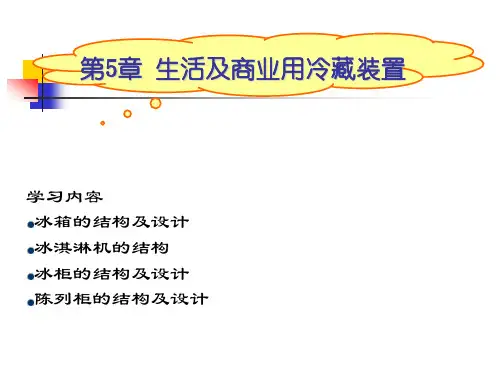
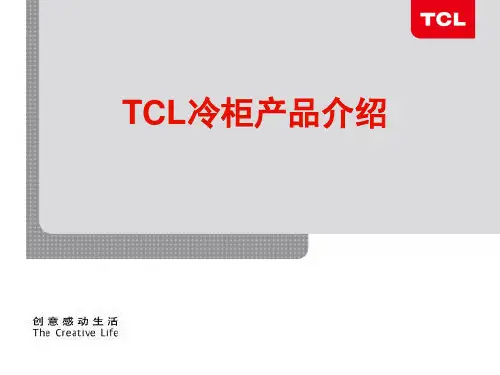
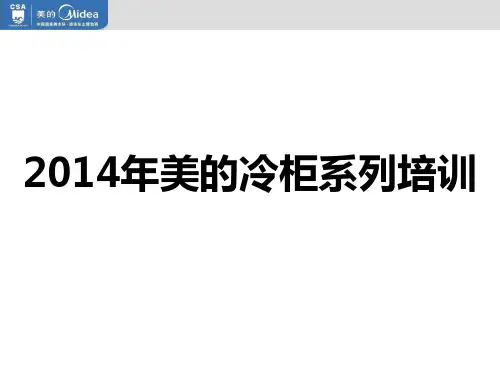
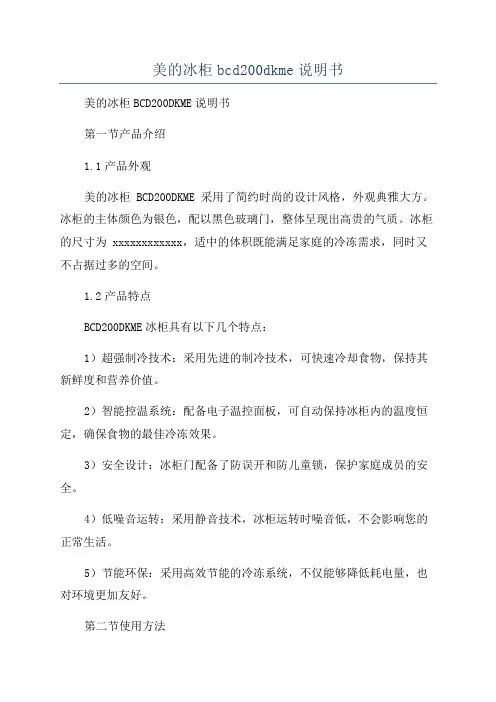
美的冰柜bcd200dkme说明书美的冰柜BCD200DKME说明书第一节产品介绍1.1产品外观美的冰柜 BCD200DKME 采用了简约时尚的设计风格,外观典雅大方。
冰柜的主体颜色为银色,配以黑色玻璃门,整体呈现出高贵的气质。
冰柜的尺寸为 xxxxxxxxxxxx,适中的体积既能满足家庭的冷冻需求,同时又不占据过多的空间。
1.2产品特点BCD200DKME冰柜具有以下几个特点:1)超强制冷技术:采用先进的制冷技术,可快速冷却食物,保持其新鲜度和营养价值。
2)智能控温系统:配备电子温控面板,可自动保持冰柜内的温度恒定,确保食物的最佳冷冻效果。
3)安全设计:冰柜门配备了防误开和防儿童锁,保护家庭成员的安全。
4)低噪音运转:采用静音技术,冰柜运转时噪音低,不会影响您的正常生活。
5)节能环保:采用高效节能的冷冻系统,不仅能够降低耗电量,也对环境更加友好。
第二节使用方法2.1开箱检查2.2电源连接冰柜的电源线采用 xxxxxxxxxxxxx 规格,请确保将电源线插入符合标准的插座中,以确保电源正常供应。
2.3接通电源确认冰柜已正确连接电源之后,将插座接通电源。
冰柜会启动制冷系统,开始运行。
2.4温度调节通过电子温控面板可以调节冰柜的温度。
根据您的需求,选择适当的温度,以保持食物的最佳冷冻效果。
第三节注意事项3.1安装位置为了保证冰柜的正常运转,请将其安放在通风良好的地方,并远离热源和阳光直射。
3.2清洁与维护定期清洁冰柜是保持其运转效果和使用寿命的关键。
请使用柔软的布擦拭冰柜外表面,避免使用腐蚀性或研磨性清洁剂。
3.3故障排除第四节常见问题解答4.1冰柜无法启动请先检查电源是否正常连接,并确认插座电源正常供应。
4.2冰柜温度不稳定请先检查冰柜门是否紧闭,并确认温控面板设置正确。
4.3冰柜有异味请先清洁冰柜内部,并保持通风良好,避免存放过于潮湿或异味较大的食物。
总结(注:以上内容仅为示例,实际说明书需根据产品的实际情况进行具体编写。

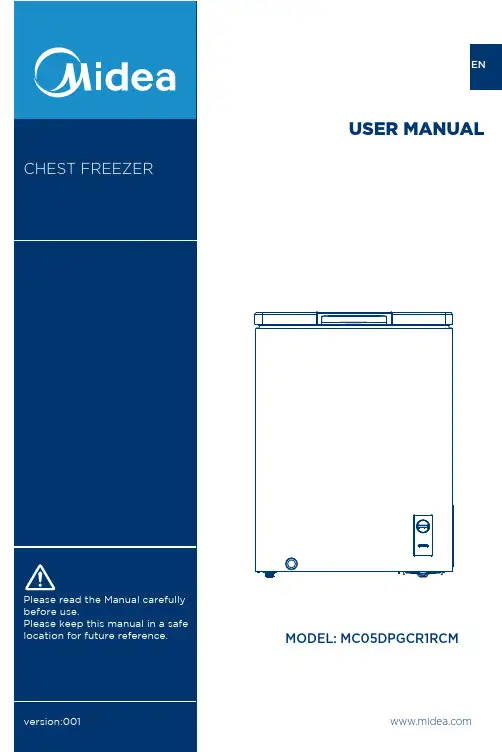
USER MANUALMODEL: MC05DPGCR1RCMMANUEL D’UTILISATIONN° DE MODÈLE : MC05DPGCR1RCMLes substances et matériaux moussants et réfrigérants à base de cyclopentane utilisés pour le congélateur sont inflammables. Par conséquent, lorsque le congélateur est mis au rebut, il doit être tenu à l’écart de toute source d’incendie et être récupéré par une entreprisespécialisée en récupération afin que l’appareil soit éliminé autrement que par combustion, et ce, afin de prévenir les dommages à l’environnement ou tout autre dommage.Les enfants doivent être sous la surveillance d’un adulte afin de s’assurer qu’ils ne jouent pas avec l’appareil.Afin d’éviter de contaminer les aliments, veuillez observer les directives suivantes :- L’ouverture prolongée de la porte peut entraîner une hausse notable de la température à l’intérieur de l’appareil.- Nettoyez régulièrement les surfaces qui peuvent être en contact avec les aliments demême que les dispositifs de drainage.- Nettoyez les réservoirs d’eau qui n’ont pas été utilisés durant 48 heures; faites un rinçage du système d’eau si l’eau n’a pas été utilisée durant cinq jours. (Remarque 1)- Rangez toute viande non cuite dans des contenants appropriés et convenants aucongélateur afin que la viande de soit pas en contact ni ne dégoutte sur d’autres aliments.- Si le congélateur est vide durant de longues périodes, veuillez l’arrête, le dégivrer, le nettoyer et l’assécher et laissez la porte ouverte afin d’éviter que des bactéries s’y logent. Note 1 : Veuillez-vous assurer si cette remarque est pertinente au type d’appareil.1.4 UtilisationNe pas démonter ou modifier le congélateur ni altérer lecircuit de refroidissement. Toute réparation de l'appareildoit être effectuée par un technicien spécialisé.Tout cordon d'alimentation endommagé doit être remplacépar le fabricant, son service technique ou un techniciencompétent afin d'éviter tout risque potentiel.L'espace entre la porte du congélateur et le congélateurest limité. Veillez à ne pas mettre la main dans cet espaceafin d'éviter de vous coincer les doigts. Pour éviter la chuted'objet, veuillez être délicat lorsque vous fermez la porteafin d'éviter la chute d'objets.Ne pas prendre les aliments ou les récipients en ayant lesmains mouillées lorsque le congélateur est en marche, enparticulier pour les récipients en métal, et ce, afin d'éviterles engelures.Ne pas laisser un enfant entrer ni monter dans le congélateur;l'étouffement ou la chute de l'enfant pourraient en résulter.Ne pas vaporiser de produit nettoyant sur le congélateur. Nepas l'installer dans un endroit où il pourrait être éclaboussépar de l'eau, et ce, afin de ne pas altérer les propriétésisolantes et les composantes électriques du congélateur.Ne pas placer d'objets lourds sur le dessus du congélateur,car ceux-ci risquent de tomber lors de l'ouverture ou lafermeture de la porte, et ce faisant ils pourraient causer desblessures.Veuillez débrancher la fiche en cas de panne de courant oulors du nettoyage. Attendre cinq minutes avant de rebrancherl'appareil afin d'éviter d'endommager le compresseur par desdémarrages successifs.make yourself at home。
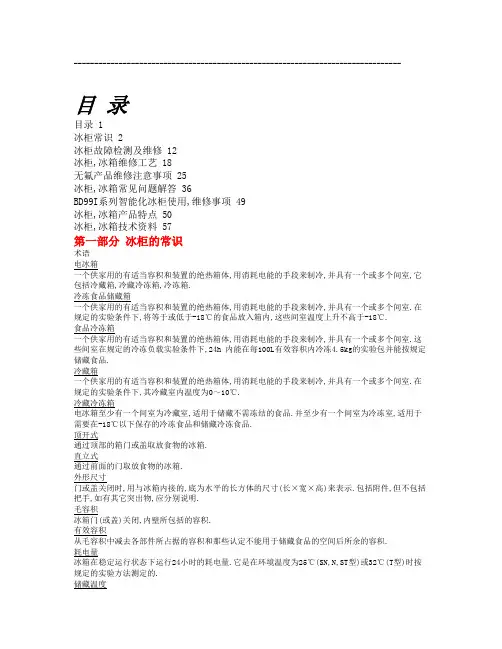
-------------------------------------------------------------------------------- 目录目录 1冰柜常识 2冰柜故障检测及维修 12冰柜,冰箱维修工艺 18无氟产品维修注意事项 25冰柜,冰箱常见问题解答 36BD99I系列智能化冰柜使用,维修事项 49冰柜,冰箱产品特点 50冰柜,冰箱技术资料 57第一部分冰柜的常识术语电冰箱一个供家用的有适当容积和装置的绝热箱体,用消耗电能的手段来制冷,并具有一个或多个间室,它包括冷藏箱,冷藏冷冻箱,冷冻箱.冷冻食品储藏箱一个供家用的有适当容积和装置的绝热箱体,用消耗电能的手段来制冷,并具有一个或多个间室.在规定的实验条件下,将等于或低于-18℃的食品放入箱内,这些间室温度上升不高于-18℃.食品冷冻箱一个供家用的有适当容积和装置的绝热箱体,用消耗电能的手段来制冷,并具有一个或多个间室.这些间室在规定的冷冻负载实验条件下,24h 内能在每100L有效容积内冷冻4.5kg的实验包并能按规定储藏食品.冷藏箱一个供家用的有适当容积和装置的绝热箱体,用消耗电能的手段来制冷,并具有一个或多个间室.在规定的实验条件下,其冷藏室内温度为0~10℃.冷藏冷冻箱电冰箱至少有一个间室为冷藏室,适用于储藏不需冻结的食品.并至少有一个间室为冷冻室,适用于需要在-18℃以下保存的冷冻食品和储藏冷冻食品.顶开式通过顶部的箱门或盖取放食物的冰箱.直立式通过前面的门取放食物的冰箱.外形尺寸门或盖关闭时,用与冰箱内接的,底为水平的长方体的尺寸(长×宽×高)来表示.包括附件,但不包括把手,如有其它突出物,应分别说明.毛容积冰箱门(或盖)关闭,内壁所包括的容积.有效容积从毛容积中减去各部件所占据的容积和那些认定不能用于储藏食品的空间后所余的容积.耗电量冰箱在稳定运行状态下运行24小时的耗电量.它是在环境温度为25℃(SN,N,ST型)或32℃(T型)时按规定的实验方法测定的.储藏温度食品冷冻箱或冷冻食品储藏箱内最热的一个"M"包的最高温度值.冷却速度在规定的实验条件下,环境温度为32℃,冰箱在空载的情况下连续运行,各个间室的瞬时温度全部达到下表规定所需时间.气候类型环境温度冷藏室冷冻室T1 ,T2,T3TmaxN型160≤T1,T2,T3≤105≤-18℃(三星级)≤-12℃(二星级)≤- 6℃(一星级)32ST型1838制冷剂在制冷系统中通过相变传递热量的流体,它在低温低压时吸收热量,在高温高压时放出热量.压缩式电冰箱冰箱的制冷过程是通过液体制冷剂在蒸发器内低压下蒸发,所生成蒸汽经机械压缩成为高压蒸汽,随后在冷凝器内冷却恢复液态制冷剂来完成.蒸发器一种热交换器,在此热交换器内,经减压后的液态制冷剂通过被冷却的介质吸收热量而被蒸发.冷凝器一种热交换器,在此热交换器内,经压缩后的汽态制冷剂通过把热量传递到外部的冷却介质中去而被液化.温控器按照蒸发器或间室的温度,自动地调节制冷系统运行的一种装置.分类电冰箱按用途可分为:a. 冷藏箱(以汉语拼音字母C表示)b. 冷藏冷冻箱(以字母CD表示)c.冷冻箱(以字母D表示)按冷藏冷冻箱使用时的环境可分为:类型气候环境温度亚温带型(SN)10~32℃温带型(N)16~32℃亚热带型(ST)18~38℃热带型(T)18~43℃型号命名产品的型号及含义如下:例如 BD-150A是第一次改进设计的150L冷冻箱;BCD-220是220L的家用冷藏冷冻箱;BC-185是185L的家用冷藏箱.另外,我公司还自制了一些企业标准,如规定SPC-206是商用啤酒冷藏柜;LST-175为两用透明玻璃推拉门冰柜;LCD-198为两用对折门冰柜;PCD-206为普通冷藏冷冻箱;SC-230为透明玻璃门冷藏箱.星级标制:三个代表冷冻室内储藏温度可达到温度约为 -18℃以下,冷冻食物的储藏时间为12周.四个代表冷冻室内储藏温度可达到温度约为 -18℃以下,并具有一定量食物的速冻能力.国际标准中规定:冷冻室有效容积50升以下时,25℃的2.5千克瘦牛肉经过24小时可冷冻至-18℃,冷冻食物的储藏时间为20周以上.(但应在食物要求的储藏期限内)另外,一个代表冷冻室内储藏温度可达到温度约为 -6℃以下,冷冻食物的储藏时间为一周.二个代表冷冻室内储藏温度可达到温度约为 -12℃以下,冷冻食物的储藏时间为四周.技术要求使用环境温度温带型(N)不高于32℃亚热带型(ST)不高于38℃热带型(T)不高于43℃使用环境相对湿度一般为75%以下,不大于90%.电源电压187~242V,电源频率50±1Hz.总有效容积电冰箱总有效容积按规定进行测算,测算值不应小于额定总有效容积的97%(有效容积单位以"L"表示).耗电量按规定试验时,冷冻箱的实测值不应大于额定值的110%,其它产品实测值不应大于额定值的115%.负载温度回升时间按规定试验时,冷冻箱中任何一个"M"包温度从-18℃回升到-9℃的时间不小于600分钟.绝热性能和防凝露冰箱应有良好的绝热性能,绝热材料不应有明显的收缩变形,也不允许冰箱外表面在正常工作时积聚过多的水汽.进行凝露实验时,冰箱外表面不允许出现珠状级或流水状级凝露.制冷系统密封性能制冷系统应密封,按规定进行检漏时任何部位制冷剂年泄漏量不能大于0.5克.噪声冰箱运行时,不应产生明显的噪声,对250L以下的冰箱,其噪声的声功率级不应大于52dB.带有风机的冷冻箱容积噪声的声功率级:300L以下≤ 55dB(A)300L~400L ≤ 60dB (A)400L~500L ≤ 63dB (A)冰柜的结构冰柜的结构可分为四大部分:保温部分,制冷系统,电器控制系统,附件.保温部分: 箱体,大盖(或门体),玻璃.箱体: 外壳,柜口,内胆,保温层(有的在靠近内胆处有蒸发器)大盖(门体):外壳,内衬,端档(上下饰条),盖(门)封条,保温层玻璃: 镀膜热反射玻璃(SD系列)或普通玻璃(上有大盖),中空玻璃(立式展示柜)内衬,柜口:工程塑料(注塑或挤压成型),有的大冰柜柜口外铝合金.内胆: 压花铝板或不锈钢,立式冰箱内胆一般为ABS塑料.保温层: 俗称泡沫塑料(聚苯乙烯泡沫塑料,硬质聚氨酯泡沫塑料),由异氢酸脂和组合聚醚反应而成,厚约50mm~70mm左右.外壳: 钢板经环氧聚脂粉末喷涂而成,大盖(或门体)的外壳有的为彩板或覆塑板.制冷系统:压缩机,冷凝器,蒸发器,干燥过滤器,毛细管,为增加制冷速度及效果,有的加有风机来强制冷却.⑴压缩机是冰柜的心脏,它使冰柜的制冷系统完成连续的循环.其功能是为制冷剂在管路中的循环提供动力,将从蒸发器中吸收热量而汽化的低温低压制冷剂气体压缩为高温高压气体,排至冷凝器中.其质量的好坏直接影响到冰柜的制冷性能.压机外部接有工艺管,回气管,排气管.压缩机电机是一种单相交流感应电动机,主要类型及特性如下:类型电阻分相起动型电容起动型电容运行型电容起动运行型特征起动转矩较小,起动电流较大,结构简单,运行可靠,适于小功率压缩机起动转矩大,起动电流小起动转矩很小,适于起动负载小的压缩机起动转矩较大,功率因数高,适于大功率压缩机压缩机的种类有很多种,冰柜常用的有往复式(包括连杆式和滑管式)和旋转式两种.连杆式压缩机,电机通过连杆带动活塞作往复运动,结构复杂,装配困难,对零件几何精度要求高,但活塞受力情况好,工作可靠.滑管式压缩机通过滑管把电机轴的旋转运动转变为活塞的往复运动,结构简单,对零件的要求低,制造简单,但活塞受力情况差.旋转式压缩机体积小,零件少,效率高,对材料及装配加工精度要求高,工艺复杂.压机附件包括:启动器保护器⑵冷凝器又称散热器,是冰柜制冷系统中主要的热交换设备之一,其作用是把从压缩机排出的高温高压制冷剂气体的热量传递到外部环境而使制冷剂变成高温高压液体.其主要种类有以下几种:结构形式钢丝盘管式内藏式翅片盘管式冷却方式自然对流冷却强制对流冷却特点传热性能良好,整体强度好,材料费用低,焊接工艺较复杂.结构紧凑,便于清理,不易损伤管,可有效防止凝露现象结构紧凑,散热效率高,冷却能力强,需配置风扇安装位置冰柜背面卧式的四周,立式的两侧卧式机压机室内(逐渐代替内藏式)⑶蒸发器的作用是使制冷剂从毛细管进入蒸发器后,因压力降低而迅速蒸发,吸取柜内食品的热量使柜内食品温度下降,达到冷冻和冷藏的目的.其主要种类有以下几种:结构形式内藏式丝管式吹涨式翅片式特点结构简单,传热性能好,便于除霜结构紧凑,传热效率高,制冷性能好传热性能好,为铝板吹涨而呈单路或多路管路结构较紧凑,传热性能好,效率高冷却方式自然对流强制对流安装位置卧式柜内壳四周立式柜冷冻室内内壳后面(多为冷藏箱)冷冻室上部(多用于风冷式冰箱)⑷干燥过滤器的作用是干燥制冷系统中的水分并过滤杂质,防止因管路堵塞而使制冷系统发生故障.它由外壳,干燥剂,端档,过滤铜网等组成.壳内装有约8-15克的干燥剂,在靠近毛细管一侧装有一定目数的铜网,分别用于吸收水分和过滤杂质.干燥剂是一种叫做分子筛的物质.分子筛是具有晶体骨架结构和吸附作用的多水复合硅铝酸盐,是性能优异的高效能选择性吸附剂,冰柜所用干燥剂是其加入一定量的粘合剂塑合而成的环型分子筛.⑸毛细管的作用是节流降压,在压缩机运行过程中,保持蒸发器与冷凝器有一定的压力差,从而使制冷剂在蒸发器中低压蒸发吸热,同时使冷凝器中的气态制冷剂在一定的高压下放热,冷凝成液态.另一方面控制制冷剂的流量,使蒸发器保持合理的热度.毛细管是一种由紫铜管冷拔加工而成的内径约为0.6-1.0毫米的铜管,系统内制冷剂的流量与其长度有关,在管径一定的情况下,与其长度成反比.电器控制系统:温控器,起动元件,过热保护器,速冻开关,指示灯,电磁阀,风扇电机.⑴温控器的作用是用来调节和控制柜内温度.当温度控制器的旋钮设在一定位置时,压缩机运行,达到规定的温度后,温控器触点断开,切断压缩机的电源;当柜内温度回升后,温度控制器的触点接通,压缩机运行,从而使柜内温度保持在旋钮指定位置规定的范围内.温控器旋钮的位置不同,其所控制的温度范围也不同.常用的温控器有压力式温控器和电子式温控器两大类.压力温控器中的普通型温控器是目前冰柜使用最多的种类.其工作原理如下:温控器感温毛细管内充有R12或氯甲烷,其末端部分固定在发泡层内感温管内(或冷藏室内),感受温度变化.当箱内温度降低时,感温管内的气体压力减小,波纹管凹陷使主臂左移,带动触点快速弹开,切短压缩机电路,停止制冷:当箱内温度升高时,感温管内气体压力升高,通过转换机构使触点闭合,接通压缩机电路,以自动控制柜内温度.⑵起动元件冰柜,冰箱的起动元件包括起动开关和起动电容.起动开关主要有起动继电器和PTC起动器.①起动继电器是一种电流继电器,其常开触点串联在起动绕组回路中,电流线圈与主绕组串联.电动机接通电源后,比额定电流大几倍的起动电流,流入继电器的电流线圈而产生足够大的电磁吸力,使触点闭合,接通起动绕组回路,电动机起动.随着转速升高,起动电流减小.当转速升高到同步转速的75-80%时,继电器线圈中流过的电流减小到所产生的电磁力不足以维持触头的闭合,此时,触点打开,切断起动绕组回路,电动机起动完毕.② PTC是一种正温度系数热敏电阻,接入起动绕组电路中,可用作电机的起动器.它的工作原理是在电机接通电源的一瞬间,PTC中流过电流的时间很短,产生热量很小,因而温度很低,电阻值很小相当于短路(触点接通),起动绕组处于导通状态,致使压缩机起动运转.当达到额定转速后,由于电流的热效应,PTC起动器温度不断升高,当温度升高到50~60℃时,电阻急剧增大,相当于断路状态,压缩机起动绕组断路,完成起动.在正常运行时,仅有一个很小的电流通过PTC,使它继续发热(产生焦耳热),保持高阻值,使起动绕组保持断开状态.PTC起动器的优点是:无触点,不会产生火花干扰;过压,欠压时也能正常工作;无磨损,寿命长,无噪声;互换性好等等几方面.起动电容接在压缩机的起动绕组电路中,当压缩机起动时,电流流过起动电容,可获得较大的起动力矩,较小的起动电流.它只在起动的瞬间工作,通电时间一般只是几秒钟,因此多采用体积小,容量大,价格低的电解电容.⑶过热保护器的作用是当冰柜发生故障使压缩机过热或通过的电流过大时,其触点断开,切断压缩机电路,使压缩机免受损失.过热保护器有外接式和内埋式两种.外接式过热保护器串联在电路中,并与压缩机外壳接触良好.澳柯玛冰柜,冰箱一般使用此种过热保护器.附件:包括门拉手,铰链,铰链盒,万向轮,压机室护板,电器盒,除霜铲,控制板等等.冰柜,冰箱制冷原理及电器控制原理制冷工作原理电源接通后,压缩机压缩制冷剂为高温高压气体,流向冷凝器,在冷凝器散热成为低温高压液体,经过干燥过滤器吸收水分,去除杂质,再由毛细管节流降压为低温低压液体,然后流经蒸发器,吸收热量降低箱内温度,成为低温低压气体,最后流回压缩机,重新压缩.如此循环多次,直至达到要求的温度. 整个制冷循环过程可分为四个阶段:绝热压缩:压缩机将蒸发后的低温低压制冷剂吸入,这时气体的理想状态是充分气化,无液滴,稍微过热.经压缩机活塞的急剧压缩,对气体所做的机械功转化为热,使之变成高温高压气体.此过程很短,被升温气体的热量几乎没有传至外部,故称为绝热压缩过程.等温压缩:压缩机将高温高压气态制冷剂送至冷凝器冷却到其完全液化,这段时间放出冷凝潜热(液化热).在此过程只有状态变化,没有温度变化,故称为等温压缩.绝热膨胀:液态制冷剂在毛细管中受到节流作用,使液体压力急剧降至蒸发压力.制冷剂在此过程中温度虽剧降,但因时间也极为短暂,未能吸收外界的热量,故称绝热膨胀.等温膨胀:进入蒸发器的制冷剂迅速蒸发,不断从冰柜内吸收热量(蒸发潜热),直到液体完全气化为止,在此过程中,制冷剂的温度恒定,故称为等温膨胀.制冷剂及常用种类制冷剂是一种化学物质,在制冷系统的管路中,当制冷剂流入蒸发器时,处于低压状态迅速气化,由液体变为气体,并吸收被冷却物质的热量,经压缩机压缩排入冷凝器中进行冷凝,在冷凝时将所带热量传给冷却介质,还原为液体,再经毛细管进入蒸发器,如此循环不停,不断作用.在制冷系统中只有上述性质的物质,称为制冷剂或制冷工质.制冷剂在系统中的状态变化是物理变化,只起吸收和排放热量的作用,本身性质并不改变,如果系统没有泄露,制冷剂可长期循环使用.常用制冷剂的特性表R12R22R134a分子式CClF2CF2Cl2C2H2F4分子量120.986.48102.04沸腾温度(℃)-29.8-40.8-26.5凝固温度(℃)-158.2-160-101对润滑油的溶解性极易溶能溶不相溶可燃可爆性无无毒性等级65a使用温度(℃)10~-4010~-50臭氧破坏潜能1.00.0温室效应潜能2.8~3.40.24~0.29电器控制原理电路原理图工作原理:电源接通,绿色指示灯亮.当箱内温度高于设定温度时,温控器触点闭合接通压缩机,使压缩机工作,红色指示灯亮;当箱内温度达到设定温度时,温控器触点断开,压缩机停机,红灯灭.当按下速冻开关时,红黄指示灯同时亮,压缩机工作不停机.现在公司的产品,指示灯因系列,型号等的不同而不同,有的只有运行灯,有的有电源指示灯,速冻开关一般是标有(I,O)的开关(按下"I"速冻开关作用),三种指示灯都有的已不多见,具体情况请参照产品或最新产品说明等.第二部分冰柜的故障检测及维修检查冰柜故障的基本步骤冰柜维修前的准备工作首先检查冰柜是否按说明书要求,实行了可靠的接地措施,以保证维修及使用的安全.检查冰柜的电气接线各部分是否有脱落,断线及短路现象,如果有此类情况,应依次进行排除.检查冰柜整机的绝缘情况,维修中检查绝缘电阻应大于2兆欧,否则应进一步检查整机的阻值情况,将万用表调至R×1欧姆档,两只表笔分别接到冰柜电源插头的L,N两端,观察万用表指示情况,正常时应为数欧姆至几十欧姆之间.若阻值为零,说明冰柜电气接线处有短路现象或压缩机,风机等可能被烧毁,造成短路,应查明原因并排除.若阻值很大,甚至电路不通,说明有断路,也应进一步检查排除. 冰柜维修的基本步骤冰柜发生故障时,其症状总会以各种情况向外部反映.因此,对于有故障的冰柜,不要急于修复,应先对其进行仔细,彻底,全面的检查,然后再进行修理.一般可分为以下几个步骤:"一听,二看,三摸,四分析,五动手".·听①听取用户对使用过程中出现的各种情况的反映和诉述.②听压机运转的声音是否正常.在接通电源后,压缩机正常的运转声音是平稳和较小的,而有些故障会直接通过不同的声音表现出来.因此可据此进行判断,如:"嗡……"为压缩机电机未能正常启动;"嗒……"为压缩机内高压引管断裂或气流声;"当……"可能为压缩机内吊簧折断,压缩机倾斜运转;"镗……"或"哐……"是气缸的液击声;"贴嗒,贴嗒……"为压缩机内启动继电器没有吸合,出现以上情况应及时停止运行,更换压缩机.③听蒸发器管道内有无气流声或流水声,正常情况下在蒸发器管道进口处(即毛细管与蒸发器连接处),有清晰的"咝……"或"哗……"的制冷剂气流声或流水声,并且均匀,连续,打开柜门时应能听到这种声音.如听不到此声音或忽大忽小甚至断断续续,忽有忽无,则属不正常.说明制冷剂泄漏或不足.·看①看蒸发器(立式)或内胆(卧式)表面结霜程度.冰柜在正常工作状态下,内胆(或蒸发器)表面结霜的厚度应均匀,基本一致,如部分结霜,结霜不均匀,甚至完全不结霜,或结一种半透明的冰霜或凝结水,则为不正常,说明制冷剂不足或泄漏.②查看管路系统,特别是各焊接处是否有油渍.制冷剂有很强的渗透性,并且制冷剂内有少量冷冻机油,正常情况下应无任何渗油痕迹,如有渗漏则渗漏处会有油迹出现,则此处即为制冷剂泄漏部位. ·摸①摸冷凝器表面的温度,冰柜连续正常工作的情况下,其上部最热,甚至发烫(此温度与环境及季节性有关);下部温度接近或稍高于环境温度,且自上而下逐渐降温.如整个冷凝器不热,或上部仅有微热,或虽较热但上下相邻二根冷凝器管道有明显温度差异,则属不正常.②摸蒸发器(立式)或内胆(卧式)表面的温度,正常情况下应达到-18℃甚至更低,用手摸会有粘手的的感觉(注意动作要快,以防手被粘住),如手感觉不到冷或很微弱,则为不正常.③摸干燥器出口处毛细管部位的温度,正常情况下有微热感.(比环境温度高,与冷凝器末端管道温度基本相同),如感到比环境温度低或高的多,甚至冰凉或凝露,结霜则为不正常.④高压排气管的温度较高,用手摸时烫手或很热,低压吸气管的温度较低,夏天管壁有时结露,用手摸有冰凉的感觉,否则即为不正常.·分析根据看,听,摸过程得到的信息,经综合分析,正确判断是否有故障及故障的部位,性质,程度.·动手通过全面,正确的分析,确定维修的方法及具体步骤,对故障的部位进行拆,换,修复,并进行性能检验.常见故障的判断及维修冰柜不制冷冰柜不制冷可分为以下三种情况:⑴压机运转正常,不制冷.①制冷剂泄漏(外漏或内漏)判断:a.压机连续运转不停机b.蒸发器不冷,冷凝器不热,部分泄漏蒸发器部分结霜和冷凝器温热.c.蒸发器无气流声或流水声.d.压机外壳不热,长时间运行后比环境温度稍高,部分泄漏为温热.e.割开回,排气管无制冷剂排出或制冷剂排出少.维修:看管道各焊接处是否有油迹,有油迹处为外泄漏部位;充0.8MPa氮气,用仪器或肥皂水检查出外泄漏部位.对外漏处补焊,焊下过滤器以0.8MPa的氮气吹扫管路15秒钟,重新焊接工艺管,更换过虑器.充0.8MPa氮气用肥皂水检漏,抽真空,重新灌注R12.无外漏时,蒸发器充1.2MPa氮气稳定后保持24小时,回压超过0.15MPa(铝制蒸发器充不超过 0.8MPa氮气检),则判定为内漏.内漏冰柜处理需更换箱体(有经验维修人员也可把内漏点检出,如在冰柜C面靠近柜口处焊点漏可焊接好后重新把柜口安装好即可).详细维修步骤见维修工艺.②脏堵判断:a.压缩机连续运转不停b.制冷剂不能在系统中循环,使得蒸发器不冷,冷凝器不热,部分堵塞蒸发器有冰凉感觉,但无霜.c.蒸发器内无气流声.d.压机外壳不热,长时间运行后比环境温度稍高,微堵为温热.e.毛细管进口端(靠近干燥过滤器连接部位)或毛细管弯曲处有冰凉的感觉,冷的部位前端即为脏堵的部位,若为完全堵塞,附近有结霜现象.f.将过滤器出口端毛细管割开,一端或两端只微量气甚至不出气.且割开工艺管无制冷剂喷出,割开排气管有大量的制冷剂喷出.维修:焊下干燥过滤器,以0.8MPa氮气加10克R12吹扫蒸发器管路20秒,将其吹畅通.换过滤器,重新焊接,抽空,灌注R12.详细维修步骤见维修工艺.③油堵判断:a.压缩机连续运转不停b.制冷剂不能在系统中循环,使得蒸发器不冷,冷凝器不热,部分堵塞蒸发器有冰凉感觉,但无霜或少霜.c.蒸发器内无气流声.d.压机外壳不热,长时间运行后比环境温度稍高,微堵为温热.e.将过滤器出口端毛细管割开,管口有油随液气喷出;或过滤器侧连续出液气,毛细管端只微量出气甚至不出气.详细维修步骤见维修工艺.⑵压机运转不久,,过热保护器断开故障原因排除方法电源电压过高;过载保护器不良,跳脱过早;起动器触点粘接;压缩机内部有短路;压缩机内部机械故障;压缩机附近温度过高.安装稳压器,调至额定值;更换过载保护器;更换起动继电器;更换压缩机;更换压缩机;增大散热空间.各排除方法的详细维修步骤见相应维修工艺.⑶压机不运转.故障原因排除方法保险丝熔断;电源插头,插座,电源线接触不良内部断线;电源电压过低,低于187V;温度控制器旋钮在停点;温度控制器失灵;起动继电器或热保护器失灵或断路;电动机起动绕组或运转绕组断线;压机的电机烧毁或转子与定子卡死;压缩机高压阀片漏气或抱轴卡死.检查有无短路现象,有则排除,否则更换相应保险丝;检查并接牢,拧紧或更换;安装稳压器或待其升到额定值;将温控器旋到合适的位置;更换相应的温度控制器;更换起动器或过热保护器;更换压缩机;更换压缩机;更换压缩机;。
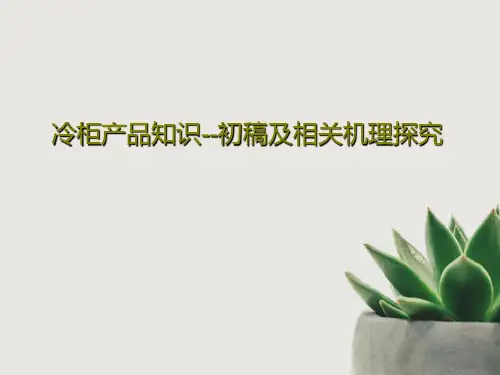
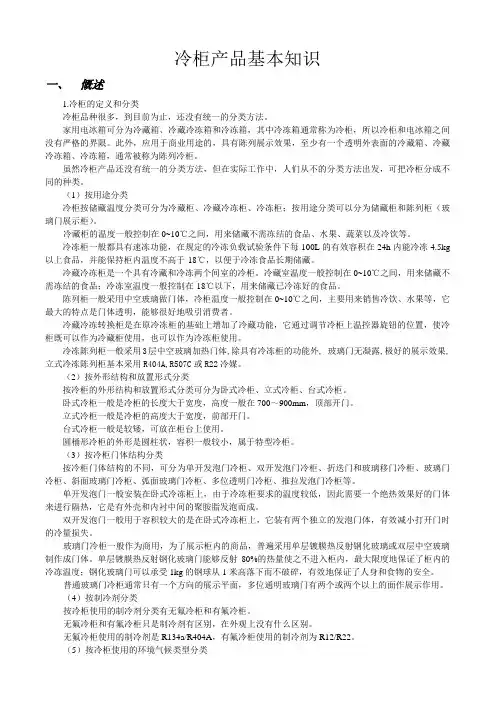
冷柜产品基本知识一、慨述1.冷柜的定义和分类冷柜品种很多,到目前为止,还没有统一的分类方法。
家用电冰箱可分为冷藏箱、冷藏冷冻箱和冷冻箱,其中冷冻箱通常称为冷柜,所以冷柜和电冰箱之间没有严格的界限。
此外,应用于商业用途的,具有陈列展示效果,至少有一个透明外表面的冷藏箱、冷藏冷冻箱、冷冻箱,通常被称为陈列冷柜。
虽然冷柜产品还没有统一的分类方法,但在实际工作中,人们从不的分类方法出发,可把冷柜分成不同的种类。
(1)按用途分类冷柜按储藏温度分类可分为冷藏柜、冷藏冷冻柜、冷冻柜;按用途分类可以分为储藏柜和陈列柜(玻璃门展示柜)。
冷藏柜的温度一般控制在0~10℃之间,用来储藏不需冻结的食品、水果、蔬菜以及冷饮等。
冷冻柜一般都具有速冻功能,在规定的冷冻负载试验条件下每100L的有效容积在24h内能冷冻4.5kg 以上食品,并能保持柜内温度不高于-18℃,以便于冷冻食品长期储藏。
冷藏冷冻柜是一个具有冷藏和冷冻两个间室的冷柜。
冷藏室温度一般控制在0~10℃之间,用来储藏不需冻结的食品;冷冻室温度一般控制在-18℃以下,用来储藏已冷冻好的食品。
陈列柜一般采用中空玻璃做门体,冷柜温度一般控制在0~10℃之间,主要用来销售冷饮、水果等,它最大的特点是门体透明,能够很好地吸引消费者。
冷藏冷冻转换柜是在原冷冻柜的基础上增加了冷藏功能,它通过调节冷柜上温控器旋钮的位置,使冷柜既可以作为冷藏柜使用,也可以作为冷冻柜使用。
冷冻陈列柜一般采用3层中空玻璃加热门体,除具有冷冻柜的功能外, 玻璃门无凝露,极好的展示效果,立式冷冻陈列柜基本采用R404A,R507C或R22冷媒。
(2)按外形结构和放置形式分类按冷柜的外形结构和放置形式分类可分为卧式冷柜、立式冷柜、台式冷柜。
卧式冷柜一般是冷柜的长度大于宽度,高度一般在700~900mm,顶部开门。
立式冷柜一般是冷柜的高度大于宽度,前部开门。
台式冷柜一般是较矮,可放在柜台上使用。
圆桶形冷柜的外形是圆柱状,容积一般较小,属于特型冷柜。
冰箱/冷柜基础知识第一章冰箱行业基本知识一、行业特点1、产能过剩,供过于求,资源浪费严重目前国内冰箱业拥有品牌20多个,生产线30多条,年生产能力已超过2500万台,而销售量不过1000万台;价格持续下滑,行业销售量的增长幅度大于销售额的增长幅度。
2、冰箱消费市场两极分化严重综合2001年、2002年、2003年上半年的中怡康市场统计报表来看,中国冰箱消费市场正在出现两极分化的趋势;2000元以下低价位冰箱市场由2001年的41.87%增长到2003年的60.47%,主要是由于农村市场的容量日渐扩大;4000元以上的高端冰箱市场份额2003年比2002年增长了25.33%,而在迅猛发展的高档冰箱市场中,多温区冰箱成为了众多消费者的首选。
3、冰箱行业进入成熟期,市场留给新进入者的机会不多城市饱和率高,市场容量有限,而且农村对冰箱的需求短期也不会迅速增长。
行业三大巨头竞争格局稳定,市场份额达60%以上,而洋品牌凭技术优势,占据了高端市场。
据不完全统计,在城市消费群中,使用5年—8年才更新冰箱的家庭占绝大多数。
所以冰箱使用的持久性更决定了消费者在选择时更加关注品牌。
4、冰箱行业的竞争进入资本竞争时代市场整合更将使行业的资源配置产生倾斜,那些实力不济的区域性品牌将很有可能就此彻底地被甩出市场;资本的渗透会加速中国冰箱业的竞争,通过深层次的投资主体的变革,为家电行业的整合提供了基础,同时,出现垄断的机会也将会随之增加。
5、挑战与机遇并存,机会大于威胁近些年,发达国家的冰箱企业纷纷将其生产基地向发展中国家转移,中国是这场大转移的中心目标。
继续驻留在发达国家本土的冰箱企业竞争优势已经大大减弱,刚刚转移到中国来的外国冰箱品牌目前立足未稳,规模不大。
因此,无论国内还是国际市场,中国冰箱企业都有一个极好的发展机会。
农村市场和海外市场,成为行业增长的新动力。
二、行业概况中国冰箱业产能达到2500万台,产量1400万台左右,国内市场销量1000万台上下,产销量增长每年在5%左右。